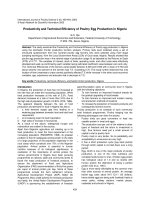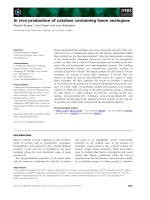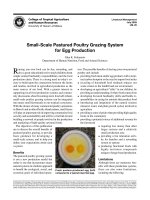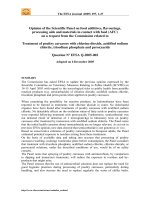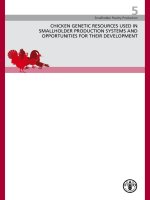Improvement in egg production of PD 3 chicken line with histopathological conditions of the jejunum up on supplementation of fermented yeast culture during and post summer season
Bạn đang xem bản rút gọn của tài liệu. Xem và tải ngay bản đầy đủ của tài liệu tại đây (239.76 KB, 7 trang )
Int.J.Curr.Microbiol.App.Sci (2017) 6(7): 379-385
International Journal of Current Microbiology and Applied Sciences
ISSN: 2319-7706 Volume 6 Number 7 (2017) pp. 379-385
Journal homepage:
Original Research Article
/>
Improvement in Egg Production of PD 3 Chicken Line with Histopathological
Conditions of the Jejunum up on Supplementation of Fermented Yeast
Culture during and Post Summer Season
N. Anand Laxmi*, M. Shanmugam, M.R. Reddy and R.K. Mahapatra
ICAR- Directorate of Poultry Research, Rajendranagar, Hyderabad, A.P., India
*Corresponding author
ABSTRACT
Keywords
Summer,
Layers,
Fermented yeast
culture,
Leptin,
Ghrelin,
MDA,
Cholesterol.
Article Info
Accepted:
04 June 2017
Available Online:
10 July 2017
During summer, under high ambient temperature conditions, the thermoregulatory system of the
body adjusts a variety of physiological mechanisms through a combination of heat exchange and
evaporative heat loss to attain a balance between the heat produced within the body and the heat lost
to the environment. In chickens sweat glands are absent making it more vulnerable for dissipation of
heat and reducing stress. Leptin affects energy homeostasis by decreasing food intake and by upregulating fatty acid oxidation. In chicken leptin and ghrelin are known as anorexigenic hormones.
Effects of yeast products on production and their mode of action in monogastrics have been reported
in poultry. It is reported that yeast products affect nutrient digestibility, growth and immune system.
Fermented yeast culture contains viable cells, cell wall components, metabolites, and the media on
which the yeast cells were grown. No study has been carried out on endocrinological and
histopathological studies with supplementation of fermented yeast culture in chicken and their
relation with egg production, especially during summer season. This study was carried out to
determine pattern of leptin and ghrelin secretion among other oxidative markers in PD 3 chicken line
(Dahlem Red) with histopathological conditions in the intestine, when subjected to natural heat stress
during summer season. During summer the temperature ranged between 26ºC and 36.9ºC and post
summer season it ranged between 29ºC and 32ºC. A hundred number of 16 week old Dahlem Red
(PD-3) breed of chickens whose body weight ranged between 850-950g were selected and randomly
allotted to two groups of fifty birds each. The experiment was continued from 16-32 weeks of age.
After eight weeks (April-May) of summer season, experiment was continued till the birds attained 32
weeks of age. The two groups were Control and Treatment groups. The treatment group received
1.25g of fermented yeast culture (Saccharomyces cerevisiae) commercial product per kg feed. Blood
samples were collected at weekly intervals, plasma was separated and analyzed for Leptin, Ghrelin
hormones, plasma protein carbonyls, MDA, cholesterol and free fatty acids. Fortnightly body weight
and feed intake of the birds were recorded. Egg production and egg weight were also recorded.
Based on these observations, feed conversion ratio (FCR) was also calculated. Supplementation of
fermented yeast culture decreased the concentration of plasma Leptin and Ghrelin (P<0.01),
Cholesterol (P<0.01) and MDA (P<0.01) during summer season and feed intake of birds during post
summer season. It was observed that the egg production increased from 26-31 weeks of age and FCR
was significantly less (P<0.05) in the supplemented group. It was observed that fertility and
hatchability of eggs was more for the supplemented group. In conclusion providing fermented yeast
culture to the sexually maturing hens during peri and post summer period improved feed efficiency,
egg production with no improvement in the morphology of the jejunum. However the severity of
necrosis decreased from medium to mild stage in both the groups from pre to post laying period.
Introduction
Hyperthermia is defined as an elevated body
temperature due to failed thermoregulation.
During hyperthermia, core body temperature
increases due to an inability to dissipate
heat(Fuquay, 1981). During the initial period
of heat stress heat shock proteins assist in
379
Int.J.Curr.Microbiol.App.Sci (2017) 6(7): 379-385
folding of the membrane proteins and
stabilize membrane lipids for maintaining the
homeostasis of the cell integrity. When the
organism gets acclimatized to elevated
temperature, it leads to decrease in the
sensitivity towards stress and the response to
the stress is delayed. One of the best
described effects of oxidative stress-generated
ROS on cells is the oxidation of membrane
lipids. The susceptibility of lipids to oxidation
is determined by its composition and degree
of saturation. Depending on the severity of
heat stress, the stress signals are activated and
which in turn determine the response of the
organism to stress. Chronic heat stress leads
to depletion of antioxidant reserves. HS has
been a great concern to the poultry producers,
especially in the tropical regions of the world,
during summer season. Chronic HS is
categorized as cyclic chronic heat stress,
which refers to a limited period of exposure to
elevated temperature followed by comfortable
temperature for the rest of the day. The
consequences of heat stress on physiological
functions are numerous, leading to
impairment in reproductive and endocrine
functions, disruption in structure and function
of intestinal epithelium. Azad et al., (2013)
observed that in chronic heat exposed
chickens, ROS production increased and was
found until d9 of HS and not thereafter, which
means that chickens became acclimatized to
the heat stress. In 18 h heat stressed chickens,
plasma and mitochondrial malondialdehyde
(MDA) was 2.1- and 2.7-fold higher (Mujahid
et al., 2007). Even though the role of appetite
regulating hormones like Leptin, Ghrelin on
feed intake, functions of liver is known (Song
et al., 2012), their role on physiological and
metabolic functions of chickens experiencing
heat stress during summer season is lacking.
In addition to being a primary organ for
absorption and digestion of nutrients, the GIT
also contains a diverse set of microbes, which
aid in metabolic processes as well as host
defense mechanisms. Impairment of small
intestinal function can occur with or without
morphological changes to the epithelium.
Functional integrity of the intestine is
dependent upon coordinated regulation of the
mucus layer, tight junctions, epithelial cells,
as well as the enteric immune system
(Groschwitz and Hogan, 2009). Nutrient
absorption optimization and post-absorptive
metabolism changes have been observed in
heat stress poultry (Garriga et al., 2006).
Appetite regulating peptides such as ghrelin,
cholecystokinin, and glucagon-like peptide 1
released from digestive tract act on the satiety
centres in the hypothalamus, which ultimately
results in reduced nutrient absorption from the
intestine (de Lartigue et al., 2011). Since
there is a strong relation between mentioned
gut hormones, feed intake, and can be
modulated by heat stress. This study was
primarily taken up for evaluating the effect of
supplementation of fermented yeast culture in
maintaining morphology of the jejunum
portion of the gut on the level of plasma
hormones, production parameters under the
influence of higher ambient temperature
during and post summer season.
Materials and Methods
Study for the summer period was carried out
from the last week of April-last week of June
(eight weeks) in the poultry farm, Directorate
of
Poultry
Research,
situated
in
Rajendranagar, Hyderabad. The month of
April and May is characterized by gradually
rising daily high temperatures, with daily high
around 37°C throughout the month, exceeding
41°C or dropping below 34°C only one day in
ten. Birds with uniform body weight ranging
between 850-950g were taken for the present
study. The birds were divided in to two
groups, one served as control and the other
served as treatment/supplemented group.
Each group contained 50 birds with five birds
in each replicate. The supplemented group
was provided with fermented yeast culture
380
Int.J.Curr.Microbiol.App.Sci (2017) 6(7): 379-385
(Saccharomyces cerevisiae) @ 1.25g/kg feed.
The experiment was initiated when the birds
were 16 weeks of age and by the end of
summer, the age of the birds was 24 weeks.
The experiment was carried out during post
summer period also, which coincided with the
laying period of the hens. The experiment
continued till the birds attained 32 weeks of
age. Fermented yeast culture @1.25g/kg was
supplemented during and also during post
summer period. Blood samples were collected
at fortnight intervals, from pectoral vein
during summer season only.
light microscope. Approval was taken from
Institutional Animal Ethics committee for
techniques involved in conducting the present
study.
Results and Discussion
The temperature during summer period varied
between 29oC-39.6oC.The circulatory level of
plasma leptin, and ghrelin were significantly
high (P<0.01) in the control when compared
with the treatment group. In the treatment and
control groups, within the group, the highest
concentration of the hormones was observed
on d21 (Table 1). Higher concentration of
anorexigenic hormones did not result in
decrease in body weight or feed intake and
difference between these parameters was not
significant between the groups. Later by d49
or by the end of summer, the level of plasma
leptin and ghrelin in the control group
decreased, but, the difference between the
level of respective hormones between the
groups was still significant (P<0.05).
The samples were centrifuged at 3000 rpm for
15 min and analysed for plasma hormones
leptin and ghrelin and other parameters
cholesterol and MDA. The hormones were
estimated with the help of commercially
available kits. Plasma MDA was analyzed
using the standard method of MDA assay
which was based on the reaction of MDA
with thiobarbituric acid (TBA); forming an
MDA-TBA2 adduct that absorbs strongly at
532 nm. Cholesterol was estimated with the
help of commercially available kit purchased
from Bio Assay Systems, CA 94545, USA.
Body weight was recorded at fortnight
interval.
The hypothalamic and gastrointestinal tract
peptides like ghrelin are involved in appetite
regulation in laying hens exposed to heat
stress (Song et al., 2012). It appeared that
birds of control group were not acclimatized
by the end of the summer period. Similar
trend
was
observed
with
plasma
malondialdehyde (MDA) levels (Table 2,
P<0.01). Plasma MDA levels indicate the
oxidative state of the lipids. It is known that
fermented yeast culture reduces MDA levels
(Matur et al., 2011). Hence in the present
study also, supplementation of fermented
yeast culture, reduced plasma MDA level,
indicating
protective
effect
of
supplementation on lipid peroxidation or in
amelioration of oxidative stress. At the end of
the experiment, level of plasma MDA
compared between the groups was not
significant indicating decrease in lipid
peroxidation in the control group (Table 2). It
Weekly feed intake was estimated. In the
laying period during post summer period,
eggs were collected daily and weight was
recorded. The birds (5 nos. from each group)
were sacrificed during first and last week of
summer period and at the end of the laying
period, jejunum portion of the digestive tract
(from the pancreatic loop to Meckel’s
diverticulum) was separated, feed particles
were removed gently by rinsing in normal
saline solution. They were fixed immediately
in 10% formalin for histopathological studies.
Samples were processed, paraffin embedded
and cut at 5u thickness. The sections were
stained with hematoxylin-eosin. The slides
were observed at 20 x magnification, under
381
Int.J.Curr.Microbiol.App.Sci (2017) 6(7): 379-385
is known that heat stress, increases plasma
cholesterol level, in the present study also, the
level of circulatory cholesterol was higher in
the control group. The rise in the
concentration of cholesterol was observed on
d21 of the experiment and continued till the
end of the study period. The concentration did
not decrease by the end of summer period in
the control group, where as in the treatment
group, supplementation of fermented yeast
culture decreased the level of plasma
cholesterol (Table 2, P<0.01) when compared
with the control group. Exposure to heat
enhances ROS production and induces
oxidative stress, which can lead to
cytotoxicity (Bernabucci et al., 2002) and
lipid peroxidation (Mujahid et al., 2007).
Table.1 Concentration of plasma leptin and ghrelin in control and supplemented group of
PD 3 chicken line (Dehlam Red) during summer season
Days
7
21
35
49
Leptin (ng/ml)
CONTROL TREATMENT
1.67**
1.23±0.09
±0.12
1.85**±0.15 1.26±0.09
1.79**±0.11 1.10±0.08
1.54*±0.09 1.23±0.12
Ghrelin (pg/ml)
CONTROL
TREATMENT
60.23*±2.30 52.10±2.10
80.57**±1.58 64.23±2.54
65.70*±2.01 50.60±1.98
58.23*±1.62 49.32±2.05
*P<0.05, **P<0.01, Values are exhibited as Mean ±SE, represented for 15d interval.
Table.2 Concentration of plasma cholesterol and MDA in control and supplemented groups of
PD 3 chicken line (Dehlam Red) during summer season
Days
7
21
35
49
Cholesterol (mg/dl)
CONTROL
212*±10.23
220*± 9.56
230*± 8.45
235*±10.45
TREATMENT
180± 9.24
155± 8.52
140±10.23
135± 9.85
MDA (uM/ml)
CONTROL
140 **±8.54
135**±7.89
91**±5.89
65±2.35
TREATMENT
68±3.21
65±1.58
58±2.03
59±1.09
*P<0.05, **P<0.01, Values are exhibited as Mean ±SE, represented for 15d interval.
Table.3 Comparison of percentage of egg production Potential post summer season
WEEKS
24
25
26
27
28
29
30
31
32
CONTROL
36.5
43.7
47.6
47.1
48.6
50.7
54.1
52.9
54.0
TREATMENT
34.8
45.8
50.6
52.1
53.7
55.5
58.2
55.1
56.7
Attainment of 50% egg production potential earlier in treatment group
Egg production was more in the treatment group (26-32 weeks)
382
Int.J.Curr.Microbiol.App.Sci (2017) 6(7): 379-385
Table.4 Percentage of fertility and hatchability
28-29 weeks
Egg set
(nos.)
CONTROL
210
TREATMENT 252
30-31 weeks
CONTROL
216
TREATMENT 230
Fertility
Hatchability
79
86
92
98
82
88
90.1
98.5
Fig.1 a) Histology of the of the jejunum (normal villi) b)
Mild to medium necrosis in jejunum portion of the gut; Fusion and thickening of villi.
Observed at 20x magnification under light microscope
Hypercholesterolemia
is
caused
by
hyperactivity of the adrenal gland (Siegel,
1995). It is known that during heat stress,
ambient temperature increases level of plasma
cortisol, which is indicative of hyperactivity
of adrenal gland. In the present study
supplementation of fermented yeast culture,
might have decreased hyper activity of
adrenals, which in turn decreased plasma
cholesterol during summer. Similar reports
are available in layers and broilers (ElHusseiny et al., 2008). Antioxidant systems
are important with regard to the scavenging of
free radicals and their metabolic products, as
well as in the maintenance of normal cellular
physiology, via the restoration of various
depleted antioxidants in stressed poultry
(Halliwell and Gutteridge, 1989). Yeast
culture or its products are also known to play
an antioxidant role, preventing lipid
peroxidation. Several studies reported that
addition of yeast or yeast culture products to
diets resulted with better feed efficiency
(Tangendjaja and Yoon, 2002), increased egg
weight (Yalcın et al., 2008) and improved
internal egg quality (Miles and Bootwalla,
1991) in hens. Addition of yeast culture
products to hen diets improved feed
efficiency (Tangendjaja and Yoon, 2002). In
the present study also, it was observed that
supplementation improved feed efficiency
significantly (4.13vs3.22, P<0.05). Others
have reported that yeast products affect
nutrient digestibility (Shin et al., 2005) and
intestinal mucosal development (Zhang et al.,
2005). The difference in the body weight and
egg weight between the groups was not
significant during post summer season. It was
observed that supplementation decreased feed
conversion ratio, but did not affect the
morphology of the jejunum portion of the
intestine. Inclusion of YC (2.5g/kg) in
broilers decreased the villus height to crypt
depth ratio (VCR) in jejunum but increased in
duodenum (Gao et al., 2008). A mild to
medium necrosis (Figure 1) was observed in
383
Int.J.Curr.Microbiol.App.Sci (2017) 6(7): 379-385
the histological sections of the jejunum with
fusion of villi. Later on occurrence of villi
necrosis was decreased in both the groups
with the decrease in ambient temperature.
Intestinal villi had more desquamation,
mostly located at the tip. Heat stress might
have
caused
these
effects,
but
supplementation of FYC did not improve the
morphology of the jejunum as observed in the
histological sections. The attainment of 50%
egg production potential was earlier in the
treatment group, and egg production was
more from 26-31 weeks when compared with
the control group (Table 3). The decrease in
egg production potential as observed for the
control group may be due to the presence of
mild necrotic condition in the jejunum, and in
addition to it the absence of supplement might
have led to less absorption of nutrients from
the digestive tract. The result with respect to
fertility and hatchability of the eggs was
observed to be higher for the treatment group
during post summer season (Table 4). The
values of different plasma parameters when
compared between control and treatment
groups, it appeared that birds of control group
were under chronic cyclic heat stress. At the
end of study period, during summer season,
from the results on different parameters, it
appeared that birds of control group were not
getting acclimatized to heat stress/high
ambient temperature, the results with respect
to egg production, fertility and hatchability
parameters for post summer period were not
at par with the supplemented group.
morphology or necrotic condition of the
jejunum, when compared between the groups.
Hence supplementation of fermented yeast
culture may prove to be beneficial.
Acknowledgements
Acknowledgements are due to Indian Council
of Agricultural Research, New Delhi, for
providing funds for carrying out the present
research work.
References
Azad, M.K.A., M. Kikusato, I. Zulkifi and
Toyomizu M. 2013. Electrolysed reduced
water decreases reactive oxygen speciesinduced oxidative damage to skeletal
muscle and improves performance in
broiler chickens exposed to medium-term
chronic heat stress. British Poultry
Science. 54:503–509.
Bernabucci, U., B. Ronchi, N. Lacetera and
Nardone, A. 2002. Markers of oxidative
status in plasma and erythrocytes of
transition dairy cows during hot season.
Journal of. Dairy Science. 85: 2173–2179.
Gao, J., H. J. Zhang, S. H. Yu, S. G. Wu, I.
Yoon, J. Quigley, Y. P. Gao and Qi, G. H.
2008, Effects of Yeast Culture in Broiler
Diets
on
Performance
and
Immunomodulatory Functions. Poultry
Science. 87: 1377-1384.
Garriga, C., R.R. Hunter, C. Amat, J.M. Planas,
M. A. Mitchell and Moreto, M. 2006,
Heat stress increases apical glucose
transport in the chicken jejunum.
American Journal of Physiology.Regulatory, Integrative Comparative.
Physiology. 290: R195-201.
Geraert, P. A., J. C. F. Padilha and Guillaumin
S. 1996, Metabolic and endocrine
changes induced by chronic heat exposure
in broiler chickens: Growth performance,
body composition and energy retention.
British Journal of Nutrition. 75:195–204.
Groschwitz, K.R. and Hogan, S.P. 2009,
Intestinal Barrier Function: Molecular
In conclusion it can be said that
supplementation of fermented yeast culture to
layers @1.25g/kg, increased egg production,
fertility, hatchability parameters during the
post summer season, by decreasing
concentration of plasma hormones, MDA and
cholesterol of PD 3 chicken line with mild to
medium necrotic conditions in the jejunum
during summer season. Supplementation did
not bring about differential effect on the
384
Int.J.Curr.Microbiol.App.Sci (2017) 6(7): 379-385
Regulation and Disease Pathogenesis.
The Journal of Allergy and Clinical
Immunology. 124: 3-22.
Halliwell, B. and Gutteridge, J. M. C. 1989,
Lipid peroxidation: a radical chain
reaction. In: Free radicals in biology and
medicine. 2nd Ed. New York: Oxford
University Press. pp. 188-218.
El-Husseiny O. M., A. G. Abdallah and AbdelLatif K.O. 2008, the influence of
biological feed additives on broiler
performance. International Journal of
Poultry Science. 7:862–871.
De Lartigue, G., C.B. de La Serre and Raybould
H.E. 2011, vagal afferent neurons in high
fat diet-induced obesity; intestinal
microflora, gut inflammation and
cholecystokinin.
Physiology
and
Behavior. 105:100-105
Matur, E., E. Ergul, I. Akyazi, E. Eraslan, G.
Inal, S. Bilgic and Demircan H. 2011,
British Journal of Poultry Science 52:541550.
Miles, R.D. and Bootwalla S.M. 1991, Directfed microbials in animal production
‘avian’. In direct-fed microbials in animal
production—a review of the literature.
National Feed Ingredients Association,
West Des Moines, IA. P. 117–146.
Mujahid, A., N. R. Pumford, W. Bottje, K.
Nakagawa, T. Miyaza-wa Y. Akiba, and
Toyomizu M. 2007, Mitochondrial
oxidative damage in chicken skeletal
muscle induced by acute heat stress.
Poultry Science. 44:439–445
Shin, Y. W., J. G. Kim, and Whang, K.Y. 2005,
Effect of supplemental mixed yeast
culture and antibiotics on nitrogen
balance of weaned pigs. Journal of
Animal Science. 83(Suppl. 1):34. (Abstr.)
Siegel, H. S. 1995, Stress, strains and
resistance. British Poultry Science. 36:3–
22.
Song, Z., L. Liu, A. Sheikhahmadi, H. Jiao and
Lin, H. 2012, Effect of heat exposure on
gene expression of feed intake regulatory
peptides in laying hens. Journal of
Biomedicine and Biotechnology. doi:
10.1155/2012/484869.
Tangendjaja, B. and Yoon, I. 2002. Effect of
yeast culture on egg production and
mortality in layer chickens. In Poultry
Science Association 91st Annual Meeting
Abstracts. August 11–14, Newark, DE.
Abstract No: 380. Pp. 89.
Yalçın, S., B. Özsoy, H. Erol and Yalçın,
S.2008, Yeast culture supplementation to
laying hen diets containing soybean meal
or sunflower seed meal and its effect on
performance, egg quality traits and blood
chemistry. Journal of Applied Poultry
Research. 17: 229-236.
Zhang, A. W., B. D. Lee, S. K. Lee, K. W. Lee,
G.H. An, K.B. Song and Lee, C. H. 2005,
Effects
of
yeast
(Saccharomyces
cerevisiae) cell components on growth
performance, meat quality, and ileal
mucosa development of broiler chicks.
Poultry Science. 84:1015–1021.
How to cite this article:
Anand Laxmi, N., M. Shanmugam, M.R. Reddy and Mahapatra, R.K. 2017. Improvement in
Egg Production of PD 3 Chicken Line with Histopathological Conditions of the Jejunum up on
Supplementation of Fermented Yeast Culture during and Post Summer Season.
Int.J.Curr.Microbiol.App.Sci. 6(7): 379-385. doi: />
385

